PROJ6005: Portfolio Management Planning Report Analysis
VerifiedAdded on 2022/11/03
|15
|4102
|372
Report
AI Summary
This report presents a comprehensive analysis of portfolio management planning, using Richard Crookes Constructions as a case study. It begins with an introduction to project portfolio management, emphasizing its significance in the construction industry and its role in aligning projects with business objectives. The report provides an overview of Richard Crookes Constructions, a family-owned construction company in Australia, highlighting its mission, values, and current operational structure. It then evaluates the situational context, identifying challenges such as the lack of a dedicated project portfolio manager and the need for improved sustainability practices. The report discusses opportunities and threats associated with implementing portfolio management, including the potential for reduced project completion times, optimized resource utilization, and enhanced sustainability. It outlines a development plan, suggesting tools and techniques to improve project selection, resource allocation, and the integration of sustainability criteria. The report concludes by summarizing the key findings and recommendations for Richard Crookes Constructions, emphasizing the strategic value of portfolio management in achieving long-term growth and competitive advantage.
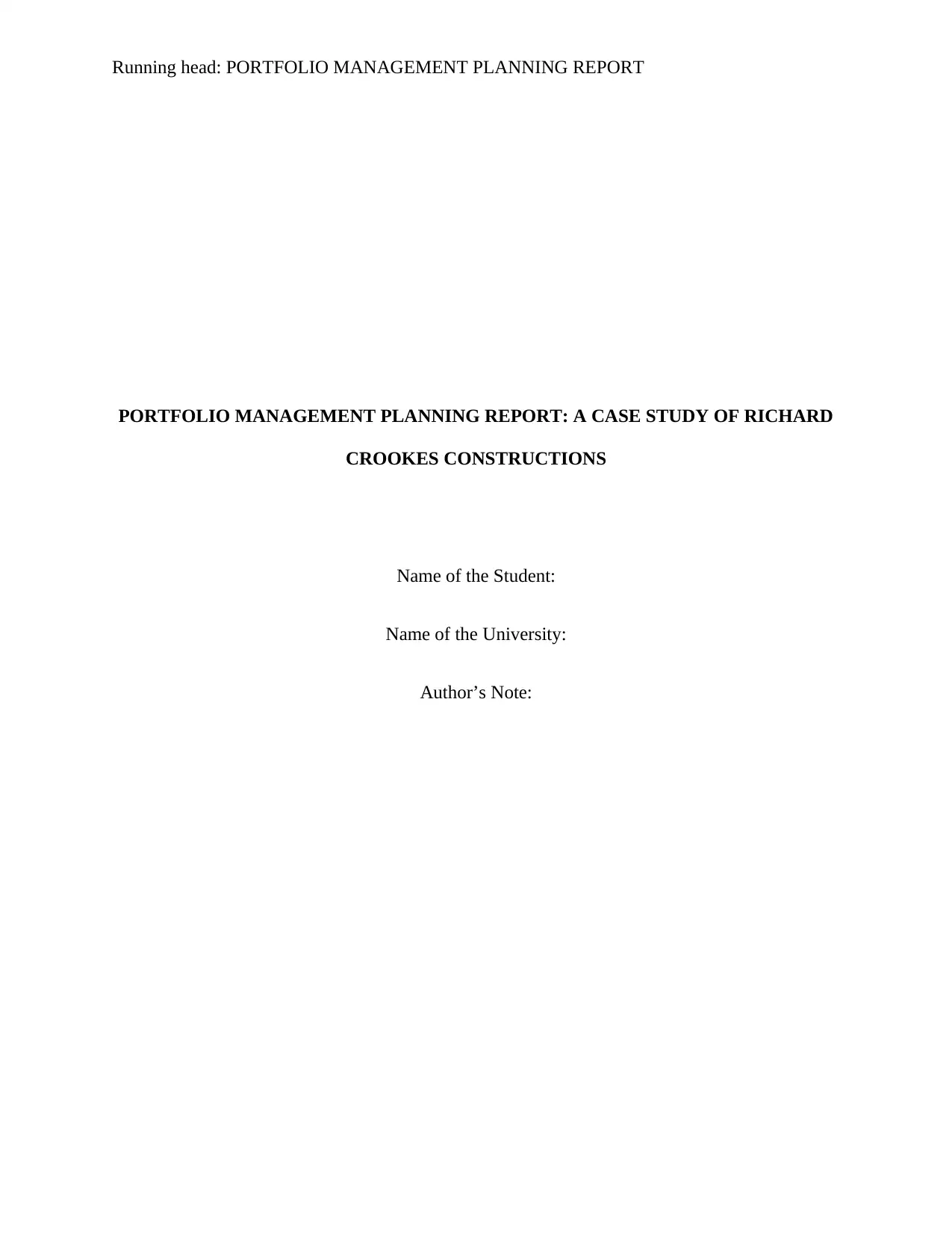
Running head: PORTFOLIO MANAGEMENT PLANNING REPORT
PORTFOLIO MANAGEMENT PLANNING REPORT: A CASE STUDY OF RICHARD
CROOKES CONSTRUCTIONS
Name of the Student:
Name of the University:
Author’s Note:
PORTFOLIO MANAGEMENT PLANNING REPORT: A CASE STUDY OF RICHARD
CROOKES CONSTRUCTIONS
Name of the Student:
Name of the University:
Author’s Note:
Paraphrase This Document
Need a fresh take? Get an instant paraphrase of this document with our AI Paraphraser
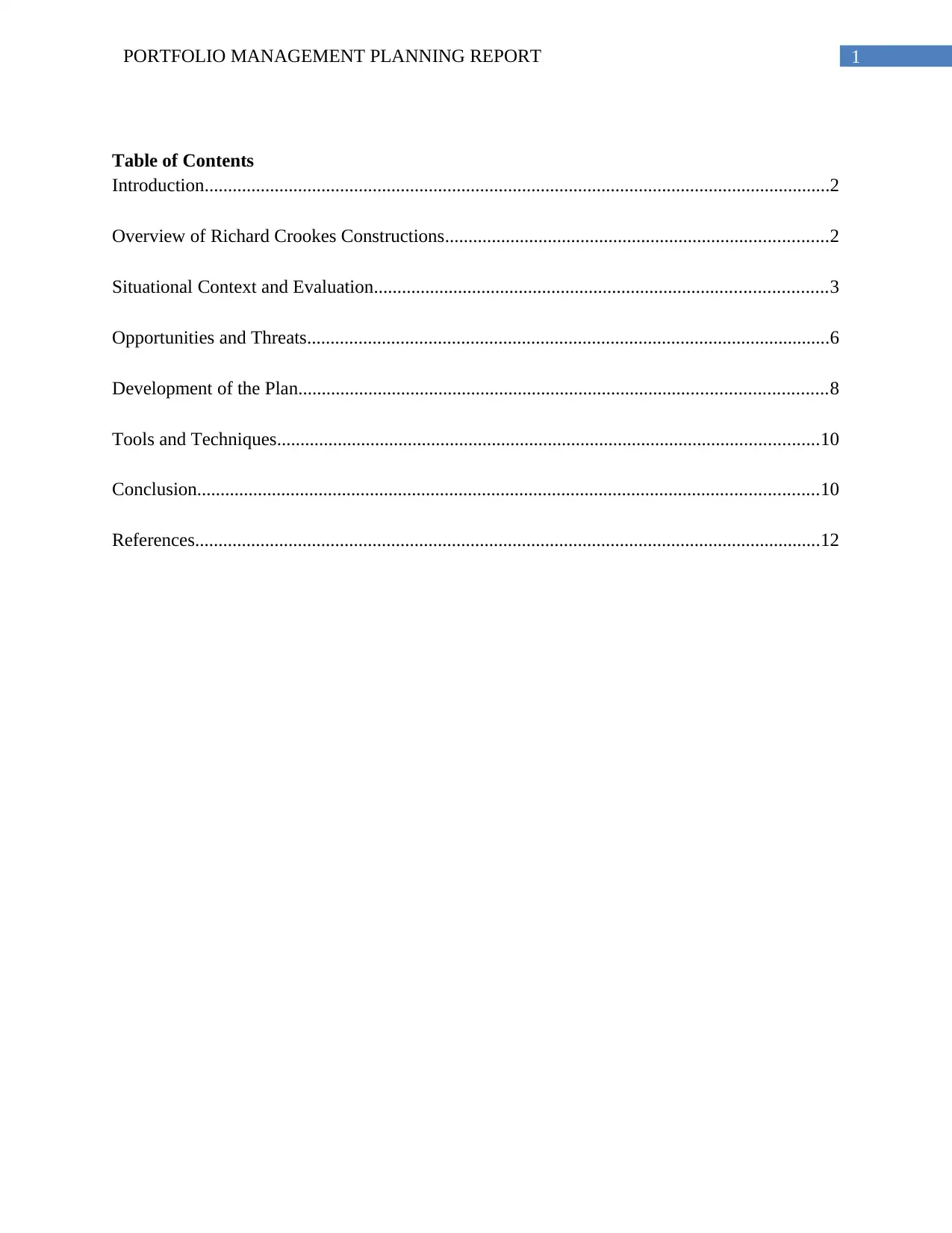
1PORTFOLIO MANAGEMENT PLANNING REPORT
Table of Contents
Introduction......................................................................................................................................2
Overview of Richard Crookes Constructions..................................................................................2
Situational Context and Evaluation.................................................................................................3
Opportunities and Threats................................................................................................................6
Development of the Plan.................................................................................................................8
Tools and Techniques....................................................................................................................10
Conclusion.....................................................................................................................................10
References......................................................................................................................................12
Table of Contents
Introduction......................................................................................................................................2
Overview of Richard Crookes Constructions..................................................................................2
Situational Context and Evaluation.................................................................................................3
Opportunities and Threats................................................................................................................6
Development of the Plan.................................................................................................................8
Tools and Techniques....................................................................................................................10
Conclusion.....................................................................................................................................10
References......................................................................................................................................12
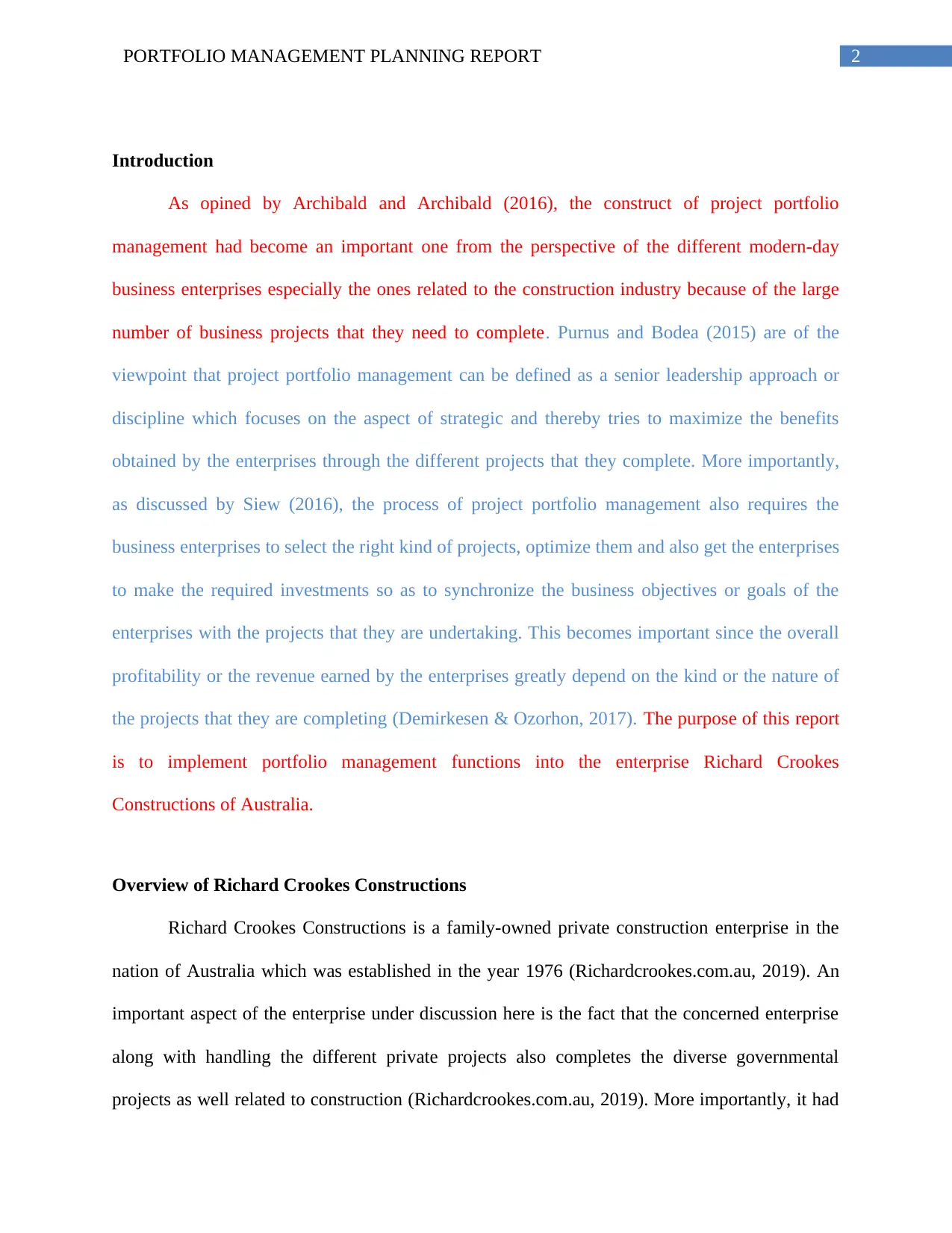
2PORTFOLIO MANAGEMENT PLANNING REPORT
Introduction
As opined by Archibald and Archibald (2016), the construct of project portfolio
management had become an important one from the perspective of the different modern-day
business enterprises especially the ones related to the construction industry because of the large
number of business projects that they need to complete. Purnus and Bodea (2015) are of the
viewpoint that project portfolio management can be defined as a senior leadership approach or
discipline which focuses on the aspect of strategic and thereby tries to maximize the benefits
obtained by the enterprises through the different projects that they complete. More importantly,
as discussed by Siew (2016), the process of project portfolio management also requires the
business enterprises to select the right kind of projects, optimize them and also get the enterprises
to make the required investments so as to synchronize the business objectives or goals of the
enterprises with the projects that they are undertaking. This becomes important since the overall
profitability or the revenue earned by the enterprises greatly depend on the kind or the nature of
the projects that they are completing (Demirkesen & Ozorhon, 2017). The purpose of this report
is to implement portfolio management functions into the enterprise Richard Crookes
Constructions of Australia.
Overview of Richard Crookes Constructions
Richard Crookes Constructions is a family-owned private construction enterprise in the
nation of Australia which was established in the year 1976 (Richardcrookes.com.au, 2019). An
important aspect of the enterprise under discussion here is the fact that the concerned enterprise
along with handling the different private projects also completes the diverse governmental
projects as well related to construction (Richardcrookes.com.au, 2019). More importantly, it had
Introduction
As opined by Archibald and Archibald (2016), the construct of project portfolio
management had become an important one from the perspective of the different modern-day
business enterprises especially the ones related to the construction industry because of the large
number of business projects that they need to complete. Purnus and Bodea (2015) are of the
viewpoint that project portfolio management can be defined as a senior leadership approach or
discipline which focuses on the aspect of strategic and thereby tries to maximize the benefits
obtained by the enterprises through the different projects that they complete. More importantly,
as discussed by Siew (2016), the process of project portfolio management also requires the
business enterprises to select the right kind of projects, optimize them and also get the enterprises
to make the required investments so as to synchronize the business objectives or goals of the
enterprises with the projects that they are undertaking. This becomes important since the overall
profitability or the revenue earned by the enterprises greatly depend on the kind or the nature of
the projects that they are completing (Demirkesen & Ozorhon, 2017). The purpose of this report
is to implement portfolio management functions into the enterprise Richard Crookes
Constructions of Australia.
Overview of Richard Crookes Constructions
Richard Crookes Constructions is a family-owned private construction enterprise in the
nation of Australia which was established in the year 1976 (Richardcrookes.com.au, 2019). An
important aspect of the enterprise under discussion here is the fact that the concerned enterprise
along with handling the different private projects also completes the diverse governmental
projects as well related to construction (Richardcrookes.com.au, 2019). More importantly, it had
⊘ This is a preview!⊘
Do you want full access?
Subscribe today to unlock all pages.

Trusted by 1+ million students worldwide
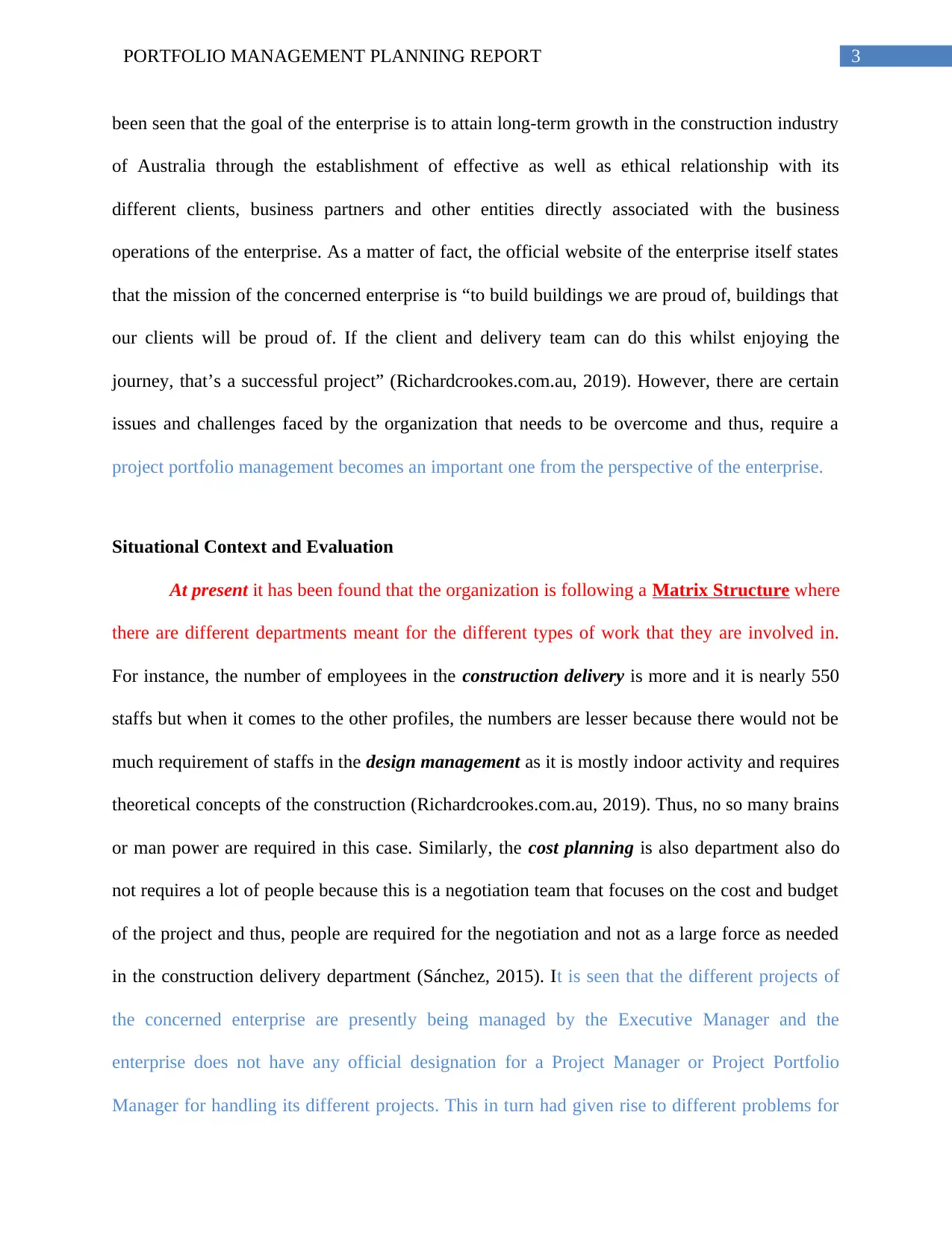
3PORTFOLIO MANAGEMENT PLANNING REPORT
been seen that the goal of the enterprise is to attain long-term growth in the construction industry
of Australia through the establishment of effective as well as ethical relationship with its
different clients, business partners and other entities directly associated with the business
operations of the enterprise. As a matter of fact, the official website of the enterprise itself states
that the mission of the concerned enterprise is “to build buildings we are proud of, buildings that
our clients will be proud of. If the client and delivery team can do this whilst enjoying the
journey, that’s a successful project” (Richardcrookes.com.au, 2019). However, there are certain
issues and challenges faced by the organization that needs to be overcome and thus, require a
project portfolio management becomes an important one from the perspective of the enterprise.
Situational Context and Evaluation
At present it has been found that the organization is following a Matrix Structure where
there are different departments meant for the different types of work that they are involved in.
For instance, the number of employees in the construction delivery is more and it is nearly 550
staffs but when it comes to the other profiles, the numbers are lesser because there would not be
much requirement of staffs in the design management as it is mostly indoor activity and requires
theoretical concepts of the construction (Richardcrookes.com.au, 2019). Thus, no so many brains
or man power are required in this case. Similarly, the cost planning is also department also do
not requires a lot of people because this is a negotiation team that focuses on the cost and budget
of the project and thus, people are required for the negotiation and not as a large force as needed
in the construction delivery department (Sánchez, 2015). It is seen that the different projects of
the concerned enterprise are presently being managed by the Executive Manager and the
enterprise does not have any official designation for a Project Manager or Project Portfolio
Manager for handling its different projects. This in turn had given rise to different problems for
been seen that the goal of the enterprise is to attain long-term growth in the construction industry
of Australia through the establishment of effective as well as ethical relationship with its
different clients, business partners and other entities directly associated with the business
operations of the enterprise. As a matter of fact, the official website of the enterprise itself states
that the mission of the concerned enterprise is “to build buildings we are proud of, buildings that
our clients will be proud of. If the client and delivery team can do this whilst enjoying the
journey, that’s a successful project” (Richardcrookes.com.au, 2019). However, there are certain
issues and challenges faced by the organization that needs to be overcome and thus, require a
project portfolio management becomes an important one from the perspective of the enterprise.
Situational Context and Evaluation
At present it has been found that the organization is following a Matrix Structure where
there are different departments meant for the different types of work that they are involved in.
For instance, the number of employees in the construction delivery is more and it is nearly 550
staffs but when it comes to the other profiles, the numbers are lesser because there would not be
much requirement of staffs in the design management as it is mostly indoor activity and requires
theoretical concepts of the construction (Richardcrookes.com.au, 2019). Thus, no so many brains
or man power are required in this case. Similarly, the cost planning is also department also do
not requires a lot of people because this is a negotiation team that focuses on the cost and budget
of the project and thus, people are required for the negotiation and not as a large force as needed
in the construction delivery department (Sánchez, 2015). It is seen that the different projects of
the concerned enterprise are presently being managed by the Executive Manager and the
enterprise does not have any official designation for a Project Manager or Project Portfolio
Manager for handling its different projects. This in turn had given rise to different problems for
Paraphrase This Document
Need a fresh take? Get an instant paraphrase of this document with our AI Paraphraser
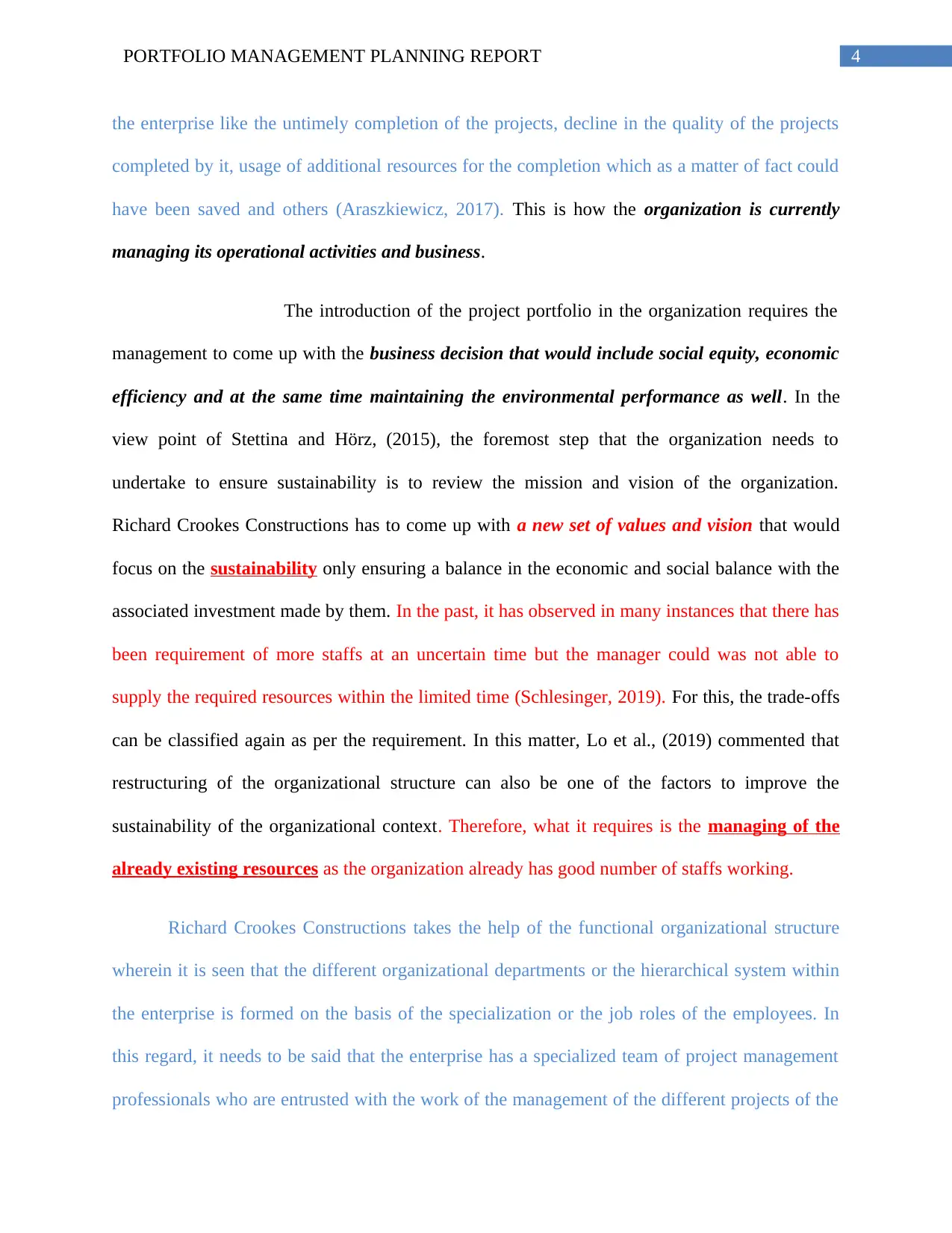
4PORTFOLIO MANAGEMENT PLANNING REPORT
the enterprise like the untimely completion of the projects, decline in the quality of the projects
completed by it, usage of additional resources for the completion which as a matter of fact could
have been saved and others (Araszkiewicz, 2017). This is how the organization is currently
managing its operational activities and business.
The introduction of the project portfolio in the organization requires the
management to come up with the business decision that would include social equity, economic
efficiency and at the same time maintaining the environmental performance as well. In the
view point of Stettina and Hörz, (2015), the foremost step that the organization needs to
undertake to ensure sustainability is to review the mission and vision of the organization.
Richard Crookes Constructions has to come up with a new set of values and vision that would
focus on the sustainability only ensuring a balance in the economic and social balance with the
associated investment made by them. In the past, it has observed in many instances that there has
been requirement of more staffs at an uncertain time but the manager could was not able to
supply the required resources within the limited time (Schlesinger, 2019). For this, the trade-offs
can be classified again as per the requirement. In this matter, Lo et al., (2019) commented that
restructuring of the organizational structure can also be one of the factors to improve the
sustainability of the organizational context. Therefore, what it requires is the managing of the
already existing resources as the organization already has good number of staffs working.
Richard Crookes Constructions takes the help of the functional organizational structure
wherein it is seen that the different organizational departments or the hierarchical system within
the enterprise is formed on the basis of the specialization or the job roles of the employees. In
this regard, it needs to be said that the enterprise has a specialized team of project management
professionals who are entrusted with the work of the management of the different projects of the
the enterprise like the untimely completion of the projects, decline in the quality of the projects
completed by it, usage of additional resources for the completion which as a matter of fact could
have been saved and others (Araszkiewicz, 2017). This is how the organization is currently
managing its operational activities and business.
The introduction of the project portfolio in the organization requires the
management to come up with the business decision that would include social equity, economic
efficiency and at the same time maintaining the environmental performance as well. In the
view point of Stettina and Hörz, (2015), the foremost step that the organization needs to
undertake to ensure sustainability is to review the mission and vision of the organization.
Richard Crookes Constructions has to come up with a new set of values and vision that would
focus on the sustainability only ensuring a balance in the economic and social balance with the
associated investment made by them. In the past, it has observed in many instances that there has
been requirement of more staffs at an uncertain time but the manager could was not able to
supply the required resources within the limited time (Schlesinger, 2019). For this, the trade-offs
can be classified again as per the requirement. In this matter, Lo et al., (2019) commented that
restructuring of the organizational structure can also be one of the factors to improve the
sustainability of the organizational context. Therefore, what it requires is the managing of the
already existing resources as the organization already has good number of staffs working.
Richard Crookes Constructions takes the help of the functional organizational structure
wherein it is seen that the different organizational departments or the hierarchical system within
the enterprise is formed on the basis of the specialization or the job roles of the employees. In
this regard, it needs to be said that the enterprise has a specialized team of project management
professionals who are entrusted with the work of the management of the different projects of the
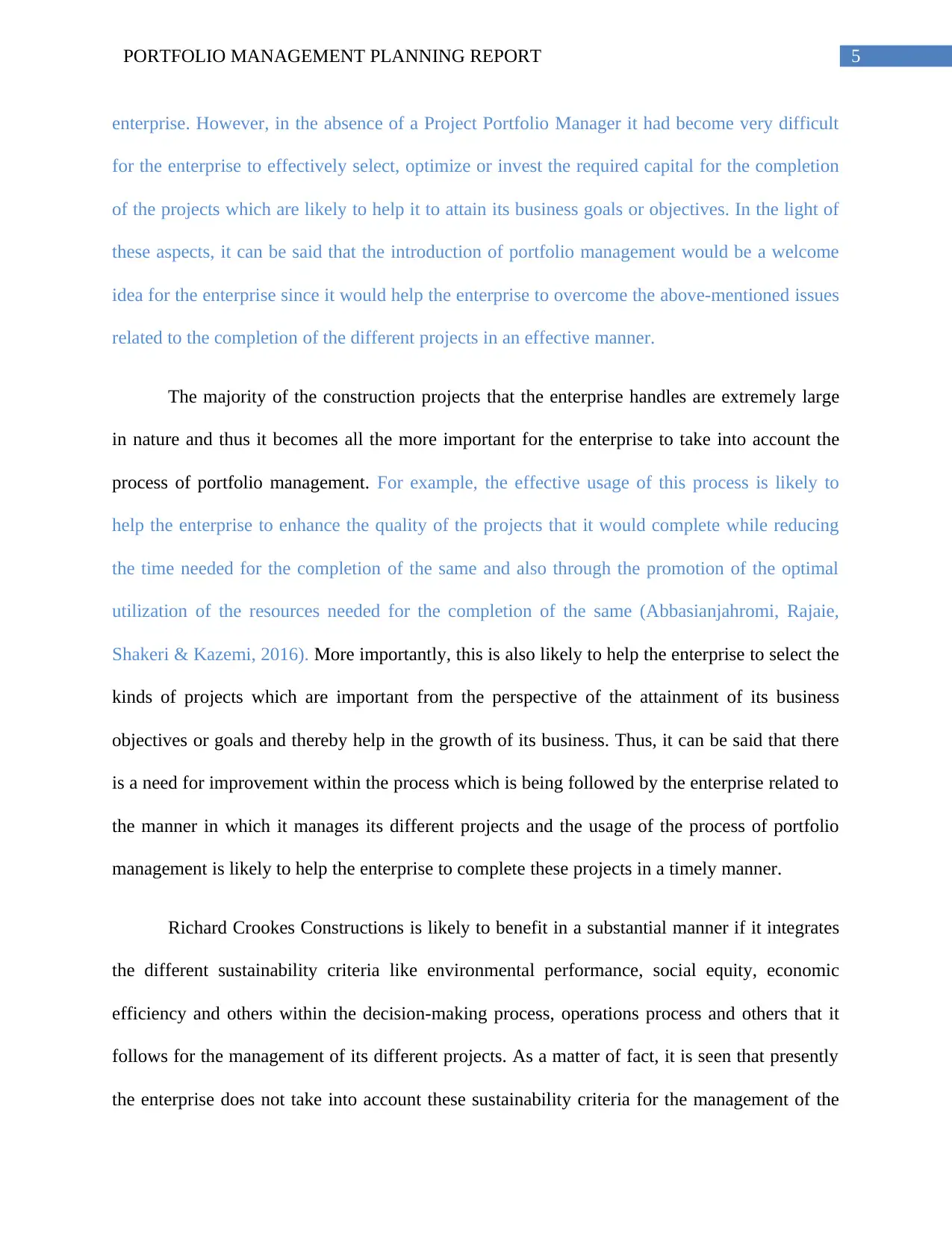
5PORTFOLIO MANAGEMENT PLANNING REPORT
enterprise. However, in the absence of a Project Portfolio Manager it had become very difficult
for the enterprise to effectively select, optimize or invest the required capital for the completion
of the projects which are likely to help it to attain its business goals or objectives. In the light of
these aspects, it can be said that the introduction of portfolio management would be a welcome
idea for the enterprise since it would help the enterprise to overcome the above-mentioned issues
related to the completion of the different projects in an effective manner.
The majority of the construction projects that the enterprise handles are extremely large
in nature and thus it becomes all the more important for the enterprise to take into account the
process of portfolio management. For example, the effective usage of this process is likely to
help the enterprise to enhance the quality of the projects that it would complete while reducing
the time needed for the completion of the same and also through the promotion of the optimal
utilization of the resources needed for the completion of the same (Abbasianjahromi, Rajaie,
Shakeri & Kazemi, 2016). More importantly, this is also likely to help the enterprise to select the
kinds of projects which are important from the perspective of the attainment of its business
objectives or goals and thereby help in the growth of its business. Thus, it can be said that there
is a need for improvement within the process which is being followed by the enterprise related to
the manner in which it manages its different projects and the usage of the process of portfolio
management is likely to help the enterprise to complete these projects in a timely manner.
Richard Crookes Constructions is likely to benefit in a substantial manner if it integrates
the different sustainability criteria like environmental performance, social equity, economic
efficiency and others within the decision-making process, operations process and others that it
follows for the management of its different projects. As a matter of fact, it is seen that presently
the enterprise does not take into account these sustainability criteria for the management of the
enterprise. However, in the absence of a Project Portfolio Manager it had become very difficult
for the enterprise to effectively select, optimize or invest the required capital for the completion
of the projects which are likely to help it to attain its business goals or objectives. In the light of
these aspects, it can be said that the introduction of portfolio management would be a welcome
idea for the enterprise since it would help the enterprise to overcome the above-mentioned issues
related to the completion of the different projects in an effective manner.
The majority of the construction projects that the enterprise handles are extremely large
in nature and thus it becomes all the more important for the enterprise to take into account the
process of portfolio management. For example, the effective usage of this process is likely to
help the enterprise to enhance the quality of the projects that it would complete while reducing
the time needed for the completion of the same and also through the promotion of the optimal
utilization of the resources needed for the completion of the same (Abbasianjahromi, Rajaie,
Shakeri & Kazemi, 2016). More importantly, this is also likely to help the enterprise to select the
kinds of projects which are important from the perspective of the attainment of its business
objectives or goals and thereby help in the growth of its business. Thus, it can be said that there
is a need for improvement within the process which is being followed by the enterprise related to
the manner in which it manages its different projects and the usage of the process of portfolio
management is likely to help the enterprise to complete these projects in a timely manner.
Richard Crookes Constructions is likely to benefit in a substantial manner if it integrates
the different sustainability criteria like environmental performance, social equity, economic
efficiency and others within the decision-making process, operations process and others that it
follows for the management of its different projects. As a matter of fact, it is seen that presently
the enterprise does not take into account these sustainability criteria for the management of the
⊘ This is a preview!⊘
Do you want full access?
Subscribe today to unlock all pages.

Trusted by 1+ million students worldwide
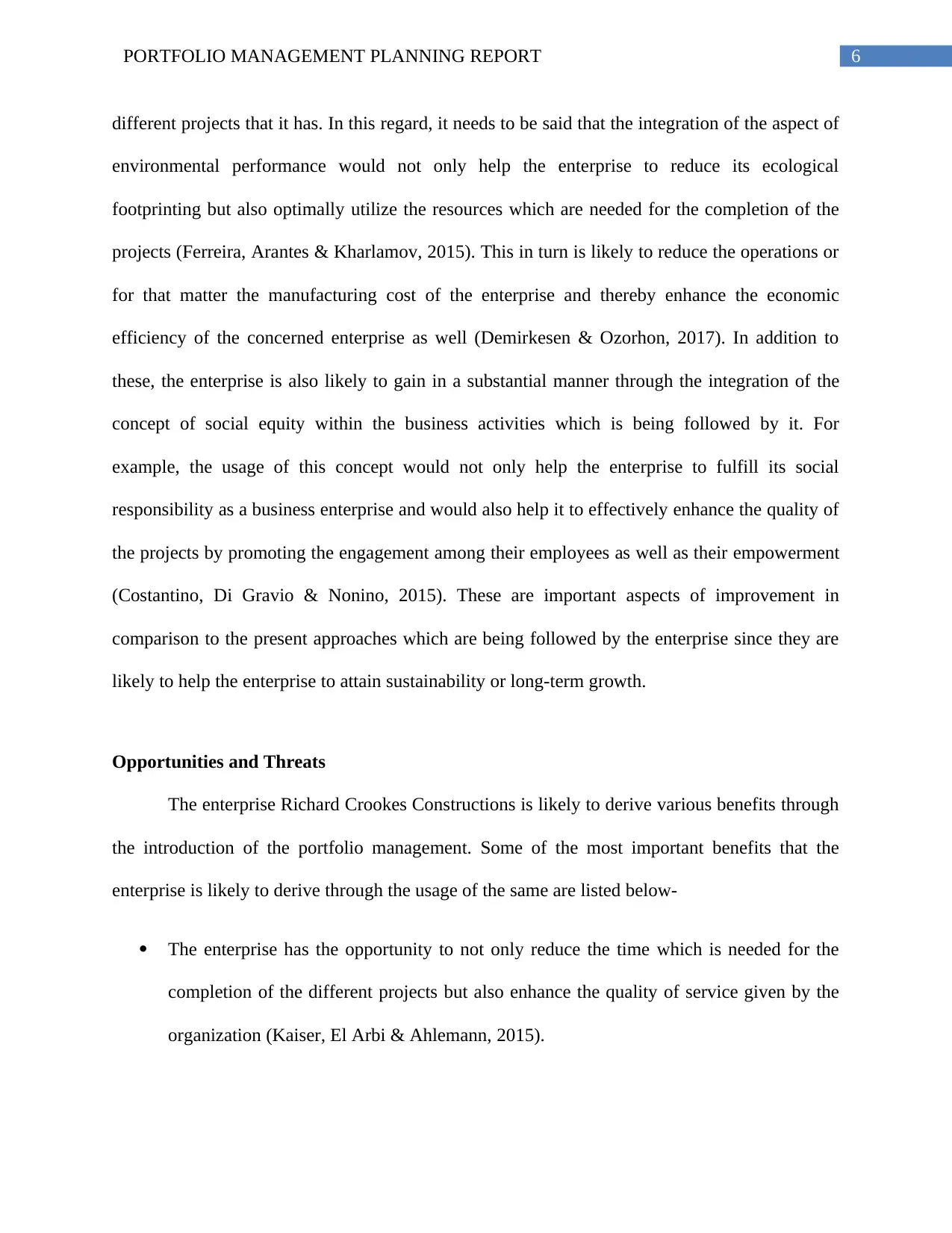
6PORTFOLIO MANAGEMENT PLANNING REPORT
different projects that it has. In this regard, it needs to be said that the integration of the aspect of
environmental performance would not only help the enterprise to reduce its ecological
footprinting but also optimally utilize the resources which are needed for the completion of the
projects (Ferreira, Arantes & Kharlamov, 2015). This in turn is likely to reduce the operations or
for that matter the manufacturing cost of the enterprise and thereby enhance the economic
efficiency of the concerned enterprise as well (Demirkesen & Ozorhon, 2017). In addition to
these, the enterprise is also likely to gain in a substantial manner through the integration of the
concept of social equity within the business activities which is being followed by it. For
example, the usage of this concept would not only help the enterprise to fulfill its social
responsibility as a business enterprise and would also help it to effectively enhance the quality of
the projects by promoting the engagement among their employees as well as their empowerment
(Costantino, Di Gravio & Nonino, 2015). These are important aspects of improvement in
comparison to the present approaches which are being followed by the enterprise since they are
likely to help the enterprise to attain sustainability or long-term growth.
Opportunities and Threats
The enterprise Richard Crookes Constructions is likely to derive various benefits through
the introduction of the portfolio management. Some of the most important benefits that the
enterprise is likely to derive through the usage of the same are listed below-
The enterprise has the opportunity to not only reduce the time which is needed for the
completion of the different projects but also enhance the quality of service given by the
organization (Kaiser, El Arbi & Ahlemann, 2015).
different projects that it has. In this regard, it needs to be said that the integration of the aspect of
environmental performance would not only help the enterprise to reduce its ecological
footprinting but also optimally utilize the resources which are needed for the completion of the
projects (Ferreira, Arantes & Kharlamov, 2015). This in turn is likely to reduce the operations or
for that matter the manufacturing cost of the enterprise and thereby enhance the economic
efficiency of the concerned enterprise as well (Demirkesen & Ozorhon, 2017). In addition to
these, the enterprise is also likely to gain in a substantial manner through the integration of the
concept of social equity within the business activities which is being followed by it. For
example, the usage of this concept would not only help the enterprise to fulfill its social
responsibility as a business enterprise and would also help it to effectively enhance the quality of
the projects by promoting the engagement among their employees as well as their empowerment
(Costantino, Di Gravio & Nonino, 2015). These are important aspects of improvement in
comparison to the present approaches which are being followed by the enterprise since they are
likely to help the enterprise to attain sustainability or long-term growth.
Opportunities and Threats
The enterprise Richard Crookes Constructions is likely to derive various benefits through
the introduction of the portfolio management. Some of the most important benefits that the
enterprise is likely to derive through the usage of the same are listed below-
The enterprise has the opportunity to not only reduce the time which is needed for the
completion of the different projects but also enhance the quality of service given by the
organization (Kaiser, El Arbi & Ahlemann, 2015).
Paraphrase This Document
Need a fresh take? Get an instant paraphrase of this document with our AI Paraphraser
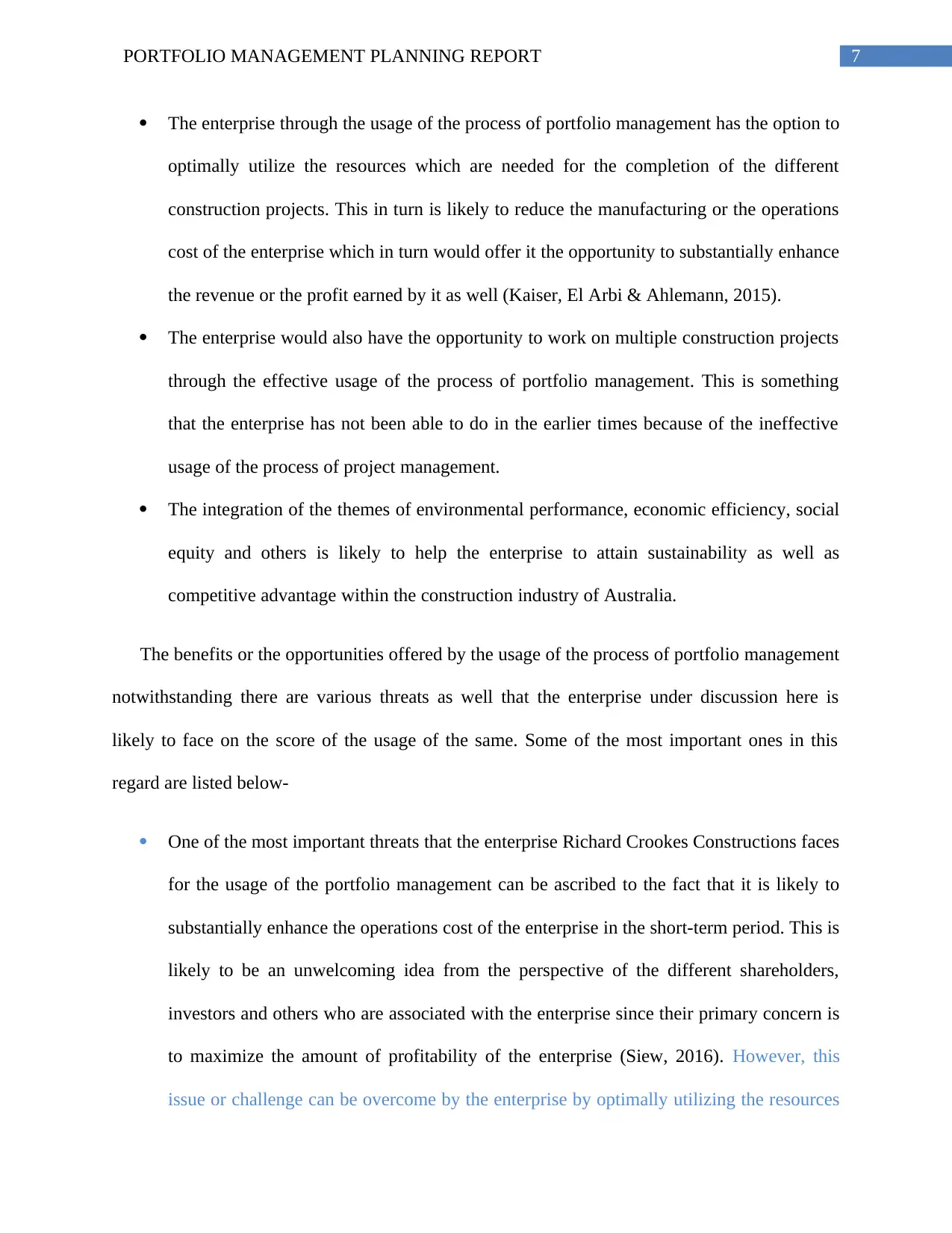
7PORTFOLIO MANAGEMENT PLANNING REPORT
The enterprise through the usage of the process of portfolio management has the option to
optimally utilize the resources which are needed for the completion of the different
construction projects. This in turn is likely to reduce the manufacturing or the operations
cost of the enterprise which in turn would offer it the opportunity to substantially enhance
the revenue or the profit earned by it as well (Kaiser, El Arbi & Ahlemann, 2015).
The enterprise would also have the opportunity to work on multiple construction projects
through the effective usage of the process of portfolio management. This is something
that the enterprise has not been able to do in the earlier times because of the ineffective
usage of the process of project management.
The integration of the themes of environmental performance, economic efficiency, social
equity and others is likely to help the enterprise to attain sustainability as well as
competitive advantage within the construction industry of Australia.
The benefits or the opportunities offered by the usage of the process of portfolio management
notwithstanding there are various threats as well that the enterprise under discussion here is
likely to face on the score of the usage of the same. Some of the most important ones in this
regard are listed below-
One of the most important threats that the enterprise Richard Crookes Constructions faces
for the usage of the portfolio management can be ascribed to the fact that it is likely to
substantially enhance the operations cost of the enterprise in the short-term period. This is
likely to be an unwelcoming idea from the perspective of the different shareholders,
investors and others who are associated with the enterprise since their primary concern is
to maximize the amount of profitability of the enterprise (Siew, 2016). However, this
issue or challenge can be overcome by the enterprise by optimally utilizing the resources
The enterprise through the usage of the process of portfolio management has the option to
optimally utilize the resources which are needed for the completion of the different
construction projects. This in turn is likely to reduce the manufacturing or the operations
cost of the enterprise which in turn would offer it the opportunity to substantially enhance
the revenue or the profit earned by it as well (Kaiser, El Arbi & Ahlemann, 2015).
The enterprise would also have the opportunity to work on multiple construction projects
through the effective usage of the process of portfolio management. This is something
that the enterprise has not been able to do in the earlier times because of the ineffective
usage of the process of project management.
The integration of the themes of environmental performance, economic efficiency, social
equity and others is likely to help the enterprise to attain sustainability as well as
competitive advantage within the construction industry of Australia.
The benefits or the opportunities offered by the usage of the process of portfolio management
notwithstanding there are various threats as well that the enterprise under discussion here is
likely to face on the score of the usage of the same. Some of the most important ones in this
regard are listed below-
One of the most important threats that the enterprise Richard Crookes Constructions faces
for the usage of the portfolio management can be ascribed to the fact that it is likely to
substantially enhance the operations cost of the enterprise in the short-term period. This is
likely to be an unwelcoming idea from the perspective of the different shareholders,
investors and others who are associated with the enterprise since their primary concern is
to maximize the amount of profitability of the enterprise (Siew, 2016). However, this
issue or challenge can be overcome by the enterprise by optimally utilizing the resources
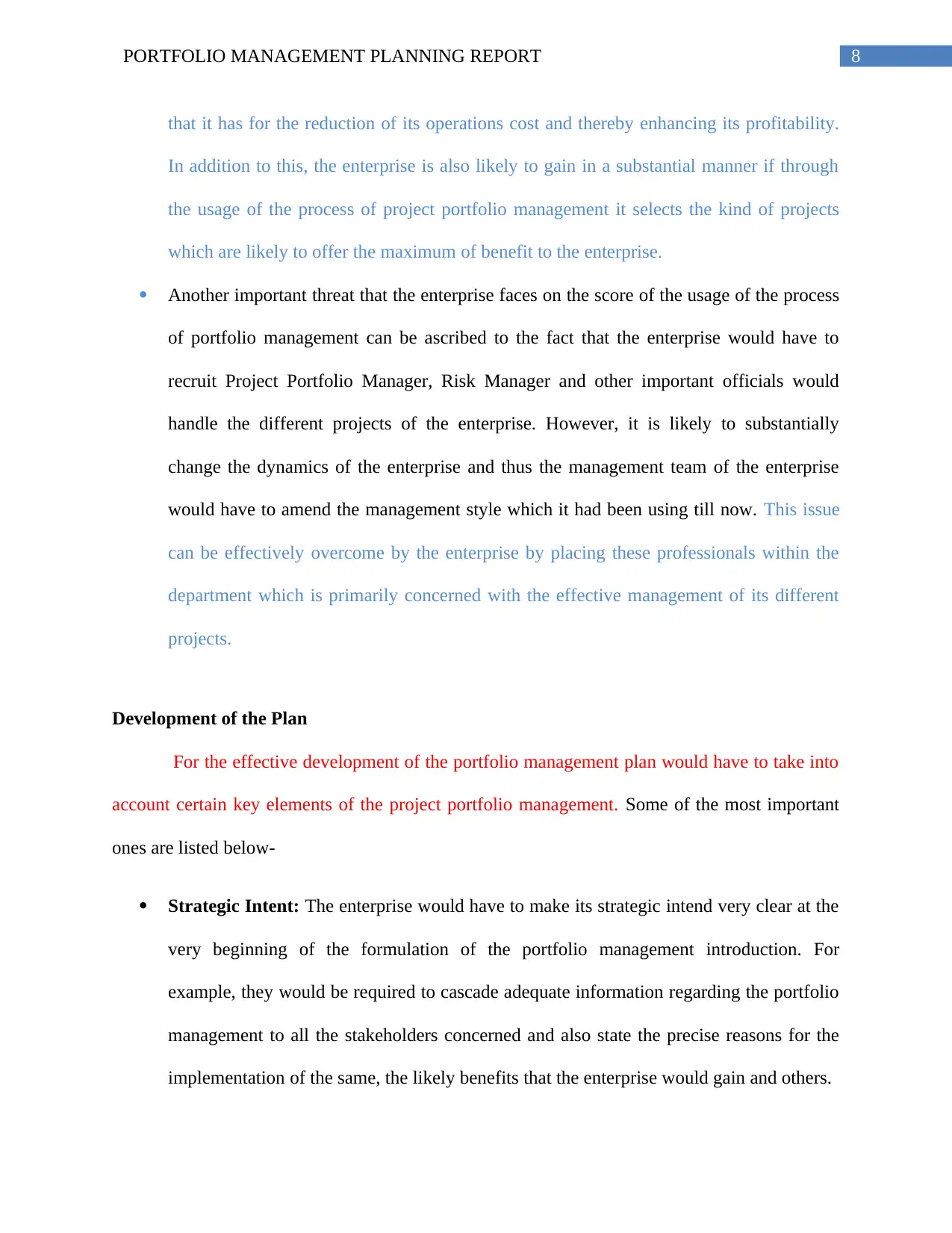
8PORTFOLIO MANAGEMENT PLANNING REPORT
that it has for the reduction of its operations cost and thereby enhancing its profitability.
In addition to this, the enterprise is also likely to gain in a substantial manner if through
the usage of the process of project portfolio management it selects the kind of projects
which are likely to offer the maximum of benefit to the enterprise.
Another important threat that the enterprise faces on the score of the usage of the process
of portfolio management can be ascribed to the fact that the enterprise would have to
recruit Project Portfolio Manager, Risk Manager and other important officials would
handle the different projects of the enterprise. However, it is likely to substantially
change the dynamics of the enterprise and thus the management team of the enterprise
would have to amend the management style which it had been using till now. This issue
can be effectively overcome by the enterprise by placing these professionals within the
department which is primarily concerned with the effective management of its different
projects.
Development of the Plan
For the effective development of the portfolio management plan would have to take into
account certain key elements of the project portfolio management. Some of the most important
ones are listed below-
Strategic Intent: The enterprise would have to make its strategic intend very clear at the
very beginning of the formulation of the portfolio management introduction. For
example, they would be required to cascade adequate information regarding the portfolio
management to all the stakeholders concerned and also state the precise reasons for the
implementation of the same, the likely benefits that the enterprise would gain and others.
that it has for the reduction of its operations cost and thereby enhancing its profitability.
In addition to this, the enterprise is also likely to gain in a substantial manner if through
the usage of the process of project portfolio management it selects the kind of projects
which are likely to offer the maximum of benefit to the enterprise.
Another important threat that the enterprise faces on the score of the usage of the process
of portfolio management can be ascribed to the fact that the enterprise would have to
recruit Project Portfolio Manager, Risk Manager and other important officials would
handle the different projects of the enterprise. However, it is likely to substantially
change the dynamics of the enterprise and thus the management team of the enterprise
would have to amend the management style which it had been using till now. This issue
can be effectively overcome by the enterprise by placing these professionals within the
department which is primarily concerned with the effective management of its different
projects.
Development of the Plan
For the effective development of the portfolio management plan would have to take into
account certain key elements of the project portfolio management. Some of the most important
ones are listed below-
Strategic Intent: The enterprise would have to make its strategic intend very clear at the
very beginning of the formulation of the portfolio management introduction. For
example, they would be required to cascade adequate information regarding the portfolio
management to all the stakeholders concerned and also state the precise reasons for the
implementation of the same, the likely benefits that the enterprise would gain and others.
⊘ This is a preview!⊘
Do you want full access?
Subscribe today to unlock all pages.

Trusted by 1+ million students worldwide
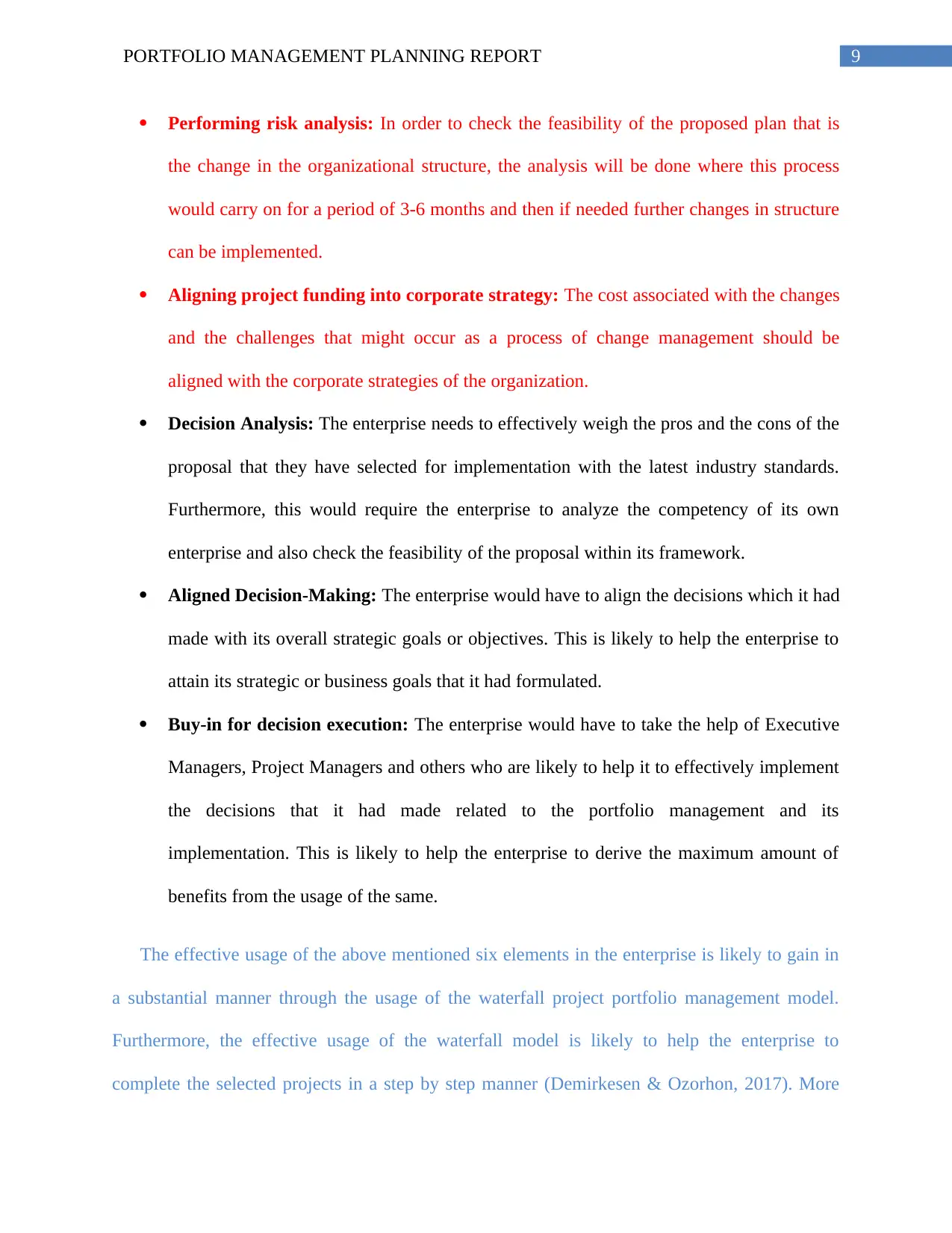
9PORTFOLIO MANAGEMENT PLANNING REPORT
Performing risk analysis: In order to check the feasibility of the proposed plan that is
the change in the organizational structure, the analysis will be done where this process
would carry on for a period of 3-6 months and then if needed further changes in structure
can be implemented.
Aligning project funding into corporate strategy: The cost associated with the changes
and the challenges that might occur as a process of change management should be
aligned with the corporate strategies of the organization.
Decision Analysis: The enterprise needs to effectively weigh the pros and the cons of the
proposal that they have selected for implementation with the latest industry standards.
Furthermore, this would require the enterprise to analyze the competency of its own
enterprise and also check the feasibility of the proposal within its framework.
Aligned Decision-Making: The enterprise would have to align the decisions which it had
made with its overall strategic goals or objectives. This is likely to help the enterprise to
attain its strategic or business goals that it had formulated.
Buy-in for decision execution: The enterprise would have to take the help of Executive
Managers, Project Managers and others who are likely to help it to effectively implement
the decisions that it had made related to the portfolio management and its
implementation. This is likely to help the enterprise to derive the maximum amount of
benefits from the usage of the same.
The effective usage of the above mentioned six elements in the enterprise is likely to gain in
a substantial manner through the usage of the waterfall project portfolio management model.
Furthermore, the effective usage of the waterfall model is likely to help the enterprise to
complete the selected projects in a step by step manner (Demirkesen & Ozorhon, 2017). More
Performing risk analysis: In order to check the feasibility of the proposed plan that is
the change in the organizational structure, the analysis will be done where this process
would carry on for a period of 3-6 months and then if needed further changes in structure
can be implemented.
Aligning project funding into corporate strategy: The cost associated with the changes
and the challenges that might occur as a process of change management should be
aligned with the corporate strategies of the organization.
Decision Analysis: The enterprise needs to effectively weigh the pros and the cons of the
proposal that they have selected for implementation with the latest industry standards.
Furthermore, this would require the enterprise to analyze the competency of its own
enterprise and also check the feasibility of the proposal within its framework.
Aligned Decision-Making: The enterprise would have to align the decisions which it had
made with its overall strategic goals or objectives. This is likely to help the enterprise to
attain its strategic or business goals that it had formulated.
Buy-in for decision execution: The enterprise would have to take the help of Executive
Managers, Project Managers and others who are likely to help it to effectively implement
the decisions that it had made related to the portfolio management and its
implementation. This is likely to help the enterprise to derive the maximum amount of
benefits from the usage of the same.
The effective usage of the above mentioned six elements in the enterprise is likely to gain in
a substantial manner through the usage of the waterfall project portfolio management model.
Furthermore, the effective usage of the waterfall model is likely to help the enterprise to
complete the selected projects in a step by step manner (Demirkesen & Ozorhon, 2017). More
Paraphrase This Document
Need a fresh take? Get an instant paraphrase of this document with our AI Paraphraser
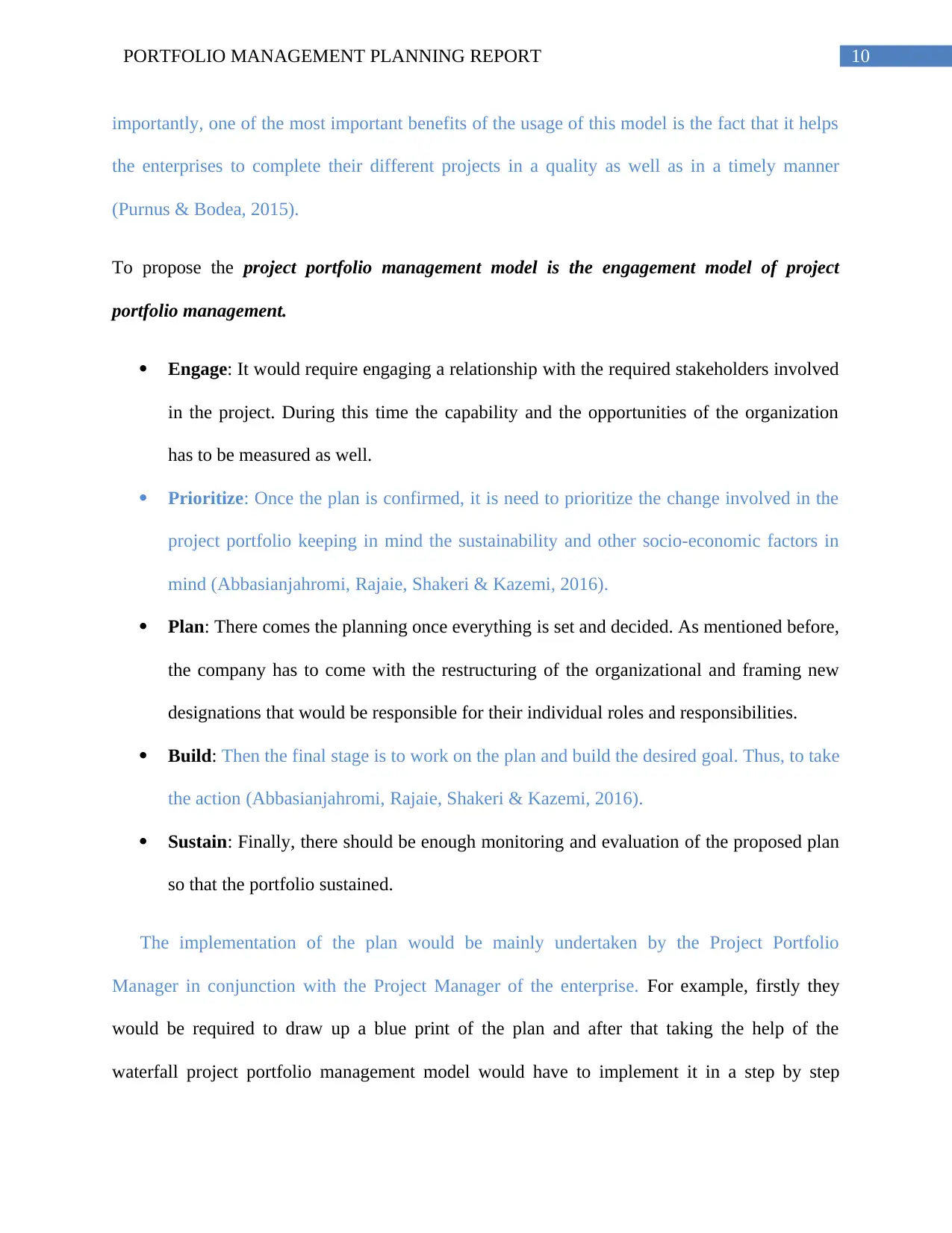
10PORTFOLIO MANAGEMENT PLANNING REPORT
importantly, one of the most important benefits of the usage of this model is the fact that it helps
the enterprises to complete their different projects in a quality as well as in a timely manner
(Purnus & Bodea, 2015).
To propose the project portfolio management model is the engagement model of project
portfolio management.
Engage: It would require engaging a relationship with the required stakeholders involved
in the project. During this time the capability and the opportunities of the organization
has to be measured as well.
Prioritize: Once the plan is confirmed, it is need to prioritize the change involved in the
project portfolio keeping in mind the sustainability and other socio-economic factors in
mind (Abbasianjahromi, Rajaie, Shakeri & Kazemi, 2016).
Plan: There comes the planning once everything is set and decided. As mentioned before,
the company has to come with the restructuring of the organizational and framing new
designations that would be responsible for their individual roles and responsibilities.
Build: Then the final stage is to work on the plan and build the desired goal. Thus, to take
the action (Abbasianjahromi, Rajaie, Shakeri & Kazemi, 2016).
Sustain: Finally, there should be enough monitoring and evaluation of the proposed plan
so that the portfolio sustained.
The implementation of the plan would be mainly undertaken by the Project Portfolio
Manager in conjunction with the Project Manager of the enterprise. For example, firstly they
would be required to draw up a blue print of the plan and after that taking the help of the
waterfall project portfolio management model would have to implement it in a step by step
importantly, one of the most important benefits of the usage of this model is the fact that it helps
the enterprises to complete their different projects in a quality as well as in a timely manner
(Purnus & Bodea, 2015).
To propose the project portfolio management model is the engagement model of project
portfolio management.
Engage: It would require engaging a relationship with the required stakeholders involved
in the project. During this time the capability and the opportunities of the organization
has to be measured as well.
Prioritize: Once the plan is confirmed, it is need to prioritize the change involved in the
project portfolio keeping in mind the sustainability and other socio-economic factors in
mind (Abbasianjahromi, Rajaie, Shakeri & Kazemi, 2016).
Plan: There comes the planning once everything is set and decided. As mentioned before,
the company has to come with the restructuring of the organizational and framing new
designations that would be responsible for their individual roles and responsibilities.
Build: Then the final stage is to work on the plan and build the desired goal. Thus, to take
the action (Abbasianjahromi, Rajaie, Shakeri & Kazemi, 2016).
Sustain: Finally, there should be enough monitoring and evaluation of the proposed plan
so that the portfolio sustained.
The implementation of the plan would be mainly undertaken by the Project Portfolio
Manager in conjunction with the Project Manager of the enterprise. For example, firstly they
would be required to draw up a blue print of the plan and after that taking the help of the
waterfall project portfolio management model would have to implement it in a step by step
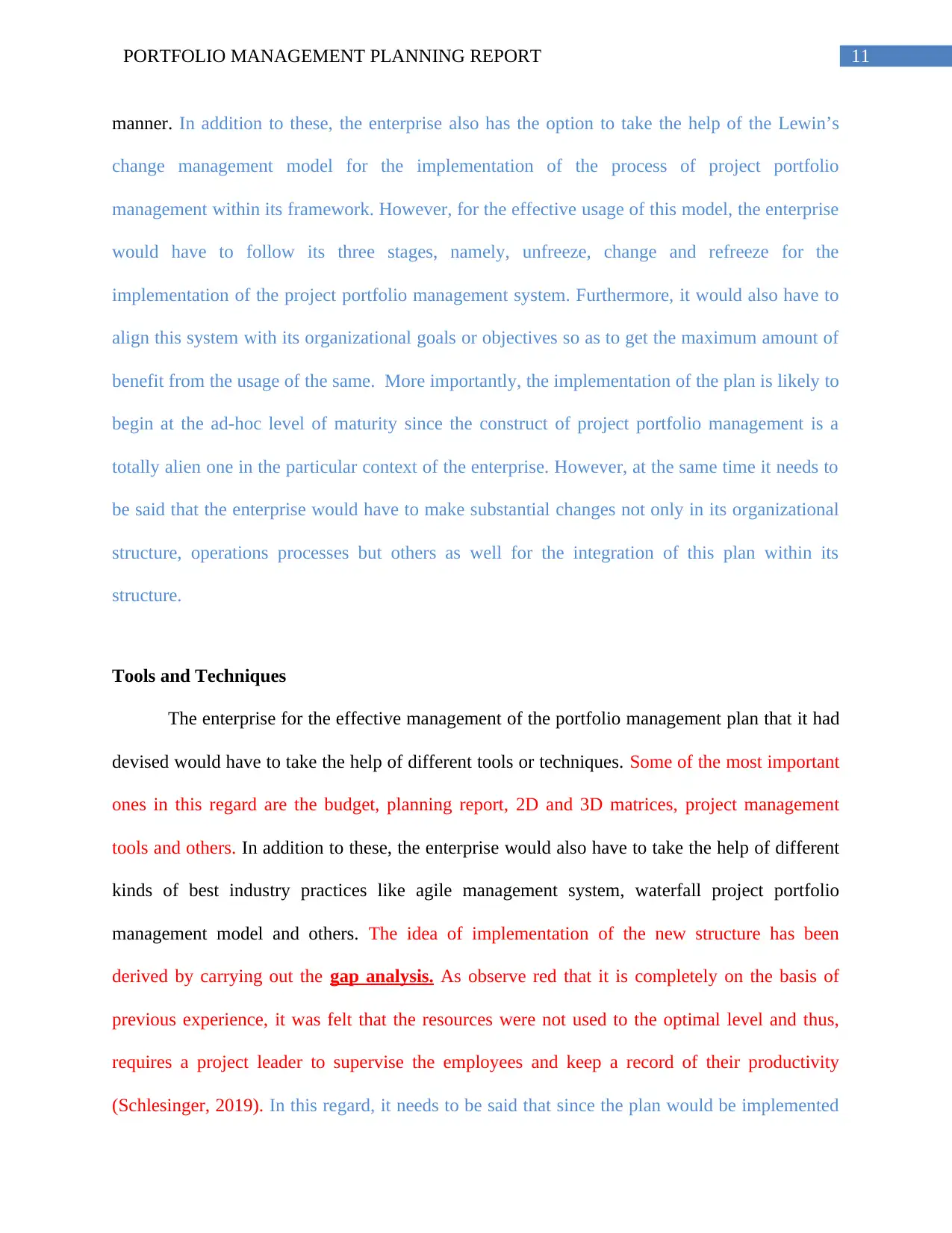
11PORTFOLIO MANAGEMENT PLANNING REPORT
manner. In addition to these, the enterprise also has the option to take the help of the Lewin’s
change management model for the implementation of the process of project portfolio
management within its framework. However, for the effective usage of this model, the enterprise
would have to follow its three stages, namely, unfreeze, change and refreeze for the
implementation of the project portfolio management system. Furthermore, it would also have to
align this system with its organizational goals or objectives so as to get the maximum amount of
benefit from the usage of the same. More importantly, the implementation of the plan is likely to
begin at the ad-hoc level of maturity since the construct of project portfolio management is a
totally alien one in the particular context of the enterprise. However, at the same time it needs to
be said that the enterprise would have to make substantial changes not only in its organizational
structure, operations processes but others as well for the integration of this plan within its
structure.
Tools and Techniques
The enterprise for the effective management of the portfolio management plan that it had
devised would have to take the help of different tools or techniques. Some of the most important
ones in this regard are the budget, planning report, 2D and 3D matrices, project management
tools and others. In addition to these, the enterprise would also have to take the help of different
kinds of best industry practices like agile management system, waterfall project portfolio
management model and others. The idea of implementation of the new structure has been
derived by carrying out the gap analysis. As observe red that it is completely on the basis of
previous experience, it was felt that the resources were not used to the optimal level and thus,
requires a project leader to supervise the employees and keep a record of their productivity
(Schlesinger, 2019). In this regard, it needs to be said that since the plan would be implemented
manner. In addition to these, the enterprise also has the option to take the help of the Lewin’s
change management model for the implementation of the process of project portfolio
management within its framework. However, for the effective usage of this model, the enterprise
would have to follow its three stages, namely, unfreeze, change and refreeze for the
implementation of the project portfolio management system. Furthermore, it would also have to
align this system with its organizational goals or objectives so as to get the maximum amount of
benefit from the usage of the same. More importantly, the implementation of the plan is likely to
begin at the ad-hoc level of maturity since the construct of project portfolio management is a
totally alien one in the particular context of the enterprise. However, at the same time it needs to
be said that the enterprise would have to make substantial changes not only in its organizational
structure, operations processes but others as well for the integration of this plan within its
structure.
Tools and Techniques
The enterprise for the effective management of the portfolio management plan that it had
devised would have to take the help of different tools or techniques. Some of the most important
ones in this regard are the budget, planning report, 2D and 3D matrices, project management
tools and others. In addition to these, the enterprise would also have to take the help of different
kinds of best industry practices like agile management system, waterfall project portfolio
management model and others. The idea of implementation of the new structure has been
derived by carrying out the gap analysis. As observe red that it is completely on the basis of
previous experience, it was felt that the resources were not used to the optimal level and thus,
requires a project leader to supervise the employees and keep a record of their productivity
(Schlesinger, 2019). In this regard, it needs to be said that since the plan would be implemented
⊘ This is a preview!⊘
Do you want full access?
Subscribe today to unlock all pages.

Trusted by 1+ million students worldwide
1 out of 15
Related Documents
Your All-in-One AI-Powered Toolkit for Academic Success.
+13062052269
info@desklib.com
Available 24*7 on WhatsApp / Email
![[object Object]](/_next/static/media/star-bottom.7253800d.svg)
Unlock your academic potential
Copyright © 2020–2025 A2Z Services. All Rights Reserved. Developed and managed by ZUCOL.





